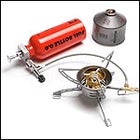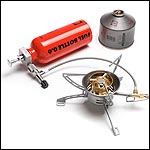Fuel is the big issue. While it’s certainly possible to purchase butane/propane fuel canisters in South America (keep in mind, you can’t take those on an airplane), it’s usually best to carry a stove that burns the widest variety of fuels possible, from kerosene to white gas.
 Primus OmniFuel
Primus OmniFuel
The very definition of such a stove is the Primus OmniFuel stove ($140, www.primus.se), which can burn many liquid fuels, as well as canister fuel. It’s also very reliable, burns hot, and is ruggedly made. On the downside, it is rather expensive, plus it’s relatively porky—11 ounces, without fuel canisters or an empty liquid-fuel container. For the most part, you’ll do just as well with MSR’s WhisperLite Internationale ($80, www.msrcorp.com), a tried-and-true stove that can be found worldwide (meaning you probably can find spare parts anywhere) and that burns most liquid fuels out there, including white gas, kerosene, diesel, jet fuel, even auto fuel.
That said, when it comes to ease of use and light weight, canister-fuel stoves can’t be beat. Check out the Snow Peak GigaPower Titanium stove ($75, www.snowpeak.com)—only three ounces! And these days, fuel canisters are available in many, many locations. I’m sure you can check ahead to secure a supply of the three or four you’ll need for most treks of seven to ten days.
Have a great trip!
More stoves tried and tested by the trail experts in �����ԹϺ���‘s
.


